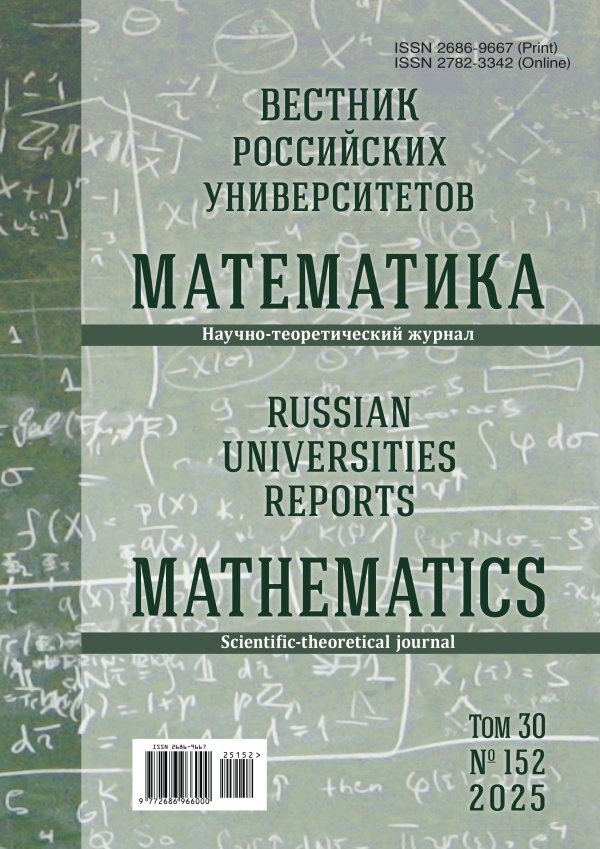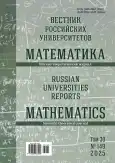Том 30, № 149 (2025)
Статьи
О множестве непрерывно дифференцируемых вогнутых продолжений булевой функции
Аннотация
Настоящая работа посвящена исследованию существования экстремальных элементов множества непрерывно дифференцируемых вогнутых продолжений на множество $[0,1]^n$ произвольной булевой функции $f_{B}(x_1,\ldots,x_n)$, а также нахождению мощности множества непрерывно дифференцируемых вогнутых продолжений на $[0,1]^n$ булевой функции $f_{B}(x_1,\ldots,x_n).$ В результате исследования доказано, что, во-первых, для любой булевой функции $f_{B}(x_1,\ldots,x_n)$ среди ее непрерывно дифференцируемых вогнутых продолжений на $[0,1]^n$ нет максимального элемента, во-вторых, если у булевой функции $f_{B}(x_1,\ldots,x_n)$ более одной существенной переменной, то среди ее непрерывно дифференцируемых вогнутых продолжений на $[0,1]^n$ нет и минимального элемента, а если булева функция постоянна или имеет лишь одну существенную переменную, то среди ее непрерывно дифференцируемых вогнутых продолжений на $[0,1]^n$ существует единственный минимальный элемент, явная форма которого приведена в работе. Также установлено, что мощность множества непрерывно дифференцируемых вогнутых продолжений на $[0,1]^n$ произвольной булевой функции $f_{B}(x_1,\ldots,x_n)$ равна континууму.
 5-14
5-14


Об оценках устойчивости сжимающих отображений первой группы Гейзенберга в теореме о неподвижной точке
Аннотация
На симметрическом $(1,q_2)$-квазиметрическом пространстве $(\Bbb H^1_{\alpha},\mathrm{Box}_{\Bbb H^1_{\alpha}}),$\! где $\mathrm{Box}_{\Bbb H^1_{\alpha}}$~--- $\mathrm{Box}$-квазиметрика первой группы Гейзенберга $\Bbb H^1_{\alpha},$ исследована константа $\mathrm{L}_{\Phi}$ в оценке устойчивости
$\mathrm{Box}_{\Bbb H^1_{\alpha}}(u,\xi)\leq\frac{\mathrm{L}_{\Phi}\mathrm{Box}_{\Bbb H^1_{\alpha}}\big(u,\Phi(u)\big)}{1-\varepsilon}$
$\varepsilon$-сжимающих отображений $\Phi$ по отношению к тождественному отображению; здесь $\xi$~--- неподвижная точка отображения $\Phi,$ $u$~--- произвольная точка группы $\Bbb H^1_{\alpha}.$ В работе установлено, что $\mathrm{L}_{\Phi}=1$ в случае, когда отображение $\Phi$ представляет собой композицию левого сдвига и однородной подгруппы растяжений.
Построены примеры сжимающих отображений $\Phi$ первой группы Гейзенбрга таких, что константа
$\mathrm{L}_{\Phi}$ не менее, чем $C\sqrt{q_2},$ где положительная константа $C$ не зависит от выбора точки $u\in\Bbb H^1_{\alpha}.$
 15-27
15-27


О некоторых свойствах движений динамических систем на компактных многообразиях
Аннотация
В статье рассматриваются движения динамической системы $g^t,$ заданной на топологическом компактном многообразии $V.$
Показано, что множество $M_1$ неблуждающих относительно $V$ точек является множеством центральных движений $\fM,$ а в множестве $\fM$ всюду плотно объединение всех компактных минимальных множеств. Установлено, что для любого движения $f(t,p)$ найдется компактное минимальное множество $\Om\subset V,$ обладающее следующим свойством: для всех $t_0\in\R$ и каждой окрестности $E_{\Om}$ множества $\Om$ вероятность принадлежности дуги $\{f(t,p)\colon t\in[t_0,t_1]\}$ траектории движения $f(t,p)$ множеству $E_{\Om}$ стремится к единице при $t_1\to+\iy;$ аналогичное утверждение справедливо также и для дуги $\{f(t,p)\colon t\in[-t_1,t_0]\}.$
Все утверждения настоящей статьи без каких-либо изменений переносятся на систему $g^t,$ заданную в хаусдорфовом секвенциально компактном топологическом пространстве.
 28-40
28-40


Гибридная глобализация сходимости метода Левенберга-Марквардта для задач оптимизации с ограничениями-равенствами
Аннотация
Метод Левенберга-Марквардта обладает локальной сверхлинейной сходимостью для общих систем нелинейных уравнений при слабых предположениях, допускающих неизолированность решений. Это обосновывает его применение к системам условий первого порядка оптимальности для задач условной оптимизации при возможном нарушении условий регулярности ограничений, что влечет неединственность множителей Лагранжа. Однако, существующие стратегии глобализации сходимости метода ЛевенберГа-Марквардта не являются оптимизационными, т.е., в случае применения к задачам оптимизации, направлены на поиск не решений, а любых стационарных точек таких задач. В этой работе предлагаются оптимизационные стратегии глобализации сходимости метода Левенберга-Марквардта для задач оптимизации с ограничениями-равенствами. Стратегии носят гибридный характер, a именно, основаны на комбинировании глобально сходящегося оптимизационного метода внешней фазы с асимптотическим переключением на метод Левенберга-Марквардта. Установлены свойства глобальной сходимости и сверхлинейная скорость. Приводятся численные результаты, подтверждающие работоспособность предложенных гибридных алгоритмов.
 41-55
41-55


О наилучшем приближении некоторых классов периодических~функций в пространстве $L_{2}$
Аннотация
Рассматривается множество $L_{2}^{(r)}$ $2\pi$-периодических функций $f\in L_{2},$ у~которых производная $(r-1)$-го порядка абсолютно непрерывна, а производная $r$-го порядка $f^{(r)}\in L_{2}.$ Решается экстремальная задача нахождения точной константы типа Джексона--Стечкина, связывающей наилучшее полиномиальное приближение функций из $L_{2}^{(r)}$ и усредненное значение обобщенного модуля непрерывности $m$-го порядка их производной $f^{(r)}$ в пространстве $L_{2}.$ Также рассмотрены классы $W_{m}^{(r)}(u)$ и $W_{m}^{(r)}(u,\Phi)$ функций из $L_{2}^{(r)}$ таких, что усредненное значение обобщенного модуля непрерывности $m$-го порядка их производной $f^{(r)}$ ограничено сверху единицей и, соответственно, значением некоторой функции $\Phi(u).$ Вычислены точные значения известных $n$-поперечников (по Бернштейну, по Гельфанду, колмогоровского, линейного и проекционного) класса $W_{m}^{(r)}(u).$ Затем решена экстремальная задача нахождения точного значения наилучшего приближения для класса $W_{m}^{(r)}(u,\Phi).$ Полученные результаты развивают и дополняют некоторые известные результаты о наилучшем приближении в $L_{2}$ различных классов функций. В~работе мы используем методы решения экстремальных задач в нормированных пространствах, а также метод оценки снизу $n$-поперечников функциональных классов в банаховых пространствах, разработанный В.\,М.~Тихомировым.
 56-65
56-65


Об оценках характеристик сбора ресурса для стохастических структурированных популяций
Аннотация
Рассматриваются модели структурированных популяций, состоящих из отдельных видов $x_1,\ldots,x_n,$ либо разделенных на $n$ возрастных групп. Предполагаем, что при отсутствии эксплуатации динамика популяции задана системой дифференциальных уравнений ${\dot x =f(x),}$ а в фиксированные моменты времени из популяции добывают случайные доли ресурса каждого из видов. Предложен способ построения управления процессом сбора ресурса, при котором ограничивают величину извлекаемого ресурса для увеличения размера следующего сбора. Получены оценки характеристик сбора ресурса, таких как средняя временная выгода и общий доход с учетом дисконтирования, выполненные с~вероятностью единица.
Предложены два метода для решения данной задачи. Первый из них можно применить для систем, обладающих свойством монотонности решений относительно начальных условий. Во втором методе нет ограничений на свойства системы, и состоит он в построении положительно инвариантных множеств, в которых находятся траектории системы при всех значениях случайных параметров. Используется понятие функции Ляпунова относительно множества, введенное Е.\,Л.~Тонковым. Приведены примеры оценки рассматриваемых характеристик для моделей взаимодействия двух видов, таких как нейтрализм и конкуренция.
 66-78
66-78


Точная оценка третьего коэффициента для ограниченных не обращающихся в нуль голоморфных функций с действительными коэффициентами
Аннотация
Пусть $\Omega_0^r$ --- класс функций $\omega,$ голоморфных в единичном круге $\Delta,$ \linebreak с~дейст\-ви\-тельными коэффициентами, удовлетворяющих условиям $|\omega(z)|<1,$ $\omega(0)=0,$ $z\in\Delta.$ Проблема коэффициентов на классе $\Omega_0^r$ формулируется следующим образом: найти необходимые и достаточные условия, которые нужно наложить на действительные числа $\{\omega\}_1, \{\omega\}_2,\ldots,$ чтобы ряд $\{\omega\}_1 z+\{\omega\}_2 z^2+\ldots$ являлся рядом Тейлора некоторой функции класса $\Omega_0^r.$
Класс $B^r$ состоит из функций $f,$ голоморфных в $\Delta,$ с действительными коэффициентами, для которых выполняются условия $0<|f(z)|\leq 1,$ $z\in\Delta.$ Подклассы $B_t^r,$ $t\geq 0,$ определяются как множество функций $f\in B^r,$ нормированных условием $f(0)=e^{-t}.$ Задача точной оценки $|\{f\}_n|,$ $n\in\mathbb{N},$ на классах $B^r$ или $B_t^r$ известна как проблема Кшижа для соответствующего класса. Очевидно, объединение всех классов $B_t^r$ исчерпывает класс $B^r$ с точностью до вращений в плоскости переменной $w$ ($w=f(z)$).
На основе решения проблемы коэффициентов для класса $\Omega_0^r$ решена задача точной оценки функционала $|\{f\}_3|$ на классах $B_t^r$ при каждом $t\geq 0.$ Для этого задача была сведена к задаче оценки функционала над классом $\Omega_0^r,$ после чего задача сведена к задаче о поиске глобального условного экстремума функции двух действительных переменных с~ограничениями типа неравенств.
Экстремальные функции найдены в двух формах: в форме выпуклой комбинации ядер Шварца, связанной с классом Каратеодори, и в форме произведений Бляшке, связанной с классом $\Omega_0^r.$
 79-92
79-92










